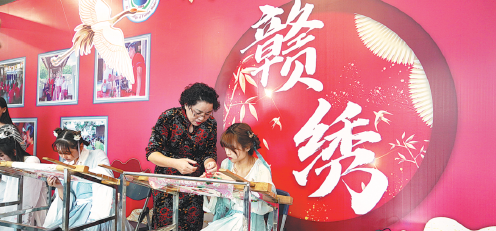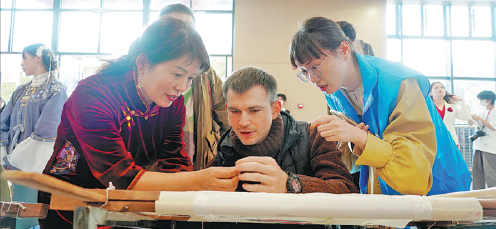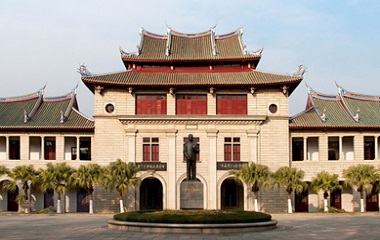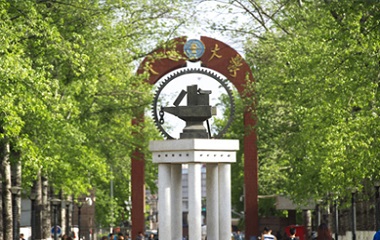Students in Jiangxi College of Foreign Studies, which is located in Nanchang city, Jiangxi province, got closer to the country's intangible cultural heritage by taking part in activities aimed at involving them in what Chinese culture is all about.
In recent years, students have been able to learn about a raft of intangible cultural heritage items through summer programs and trips to bases of patriotic education.
But for the students, merely watching and experiencing those items were not enough. They hope to create their own works to put their understanding and spirit into action, the college said.
Students of the school's embroidery association have collaborated with Yu Zhenglian, inheritor of the intangible cultural heritage of Jiangxi embroidery, to make an embroidery product. The product features a Jiangxi-Europe freight train on a world map.
"Instead of tracing ink paintings onto the fabric as a step of embroidering Jiangxi embroidery, we picked modern graphic design created by our classmates. The stitches we used are exclusive to Jiangxi embroidery," said Lyu Huiying, who belongs to the association.
Intangible cultural heritage plays an important role in promoting cultural exchanges between China and other countries. It helps expand the influence of traditional Chinese culture and arts, an executive of the college said.
This explains why the college held a training course in West Africa's Equatorial Guinea in 2018, teaching 27 residents there about embroidery and bamboo weaving.
"Bamboo weaving in Ruichang, Jiangxi province, boasts diverse shapes. We want to share its charm with friends across the globe and attract more attention to Chinese culture," said Chen Wenrui, a student at the college's club for community volunteer service.
"We made a video of the technique, added French and Russian subtitles, and posted it online to reach a vast audience," Chen said.
There is also an incubator for intangible cultural heritage-related projects in the college, which has turned many creative ideas into products. One of them is centered on oilpaper umbrellas made in Jialu village in Wuyuan county, Jiangxi. With flower patterns beloved by local people, the umbrella has been given a new life, said Li Chao, a teacher who is in charge of entrepreneurship in the college.
The project team has been under the direction of Dai Gensheng, the national inheritor of oilpaper umbrella craft in Jialu village. The umbrella the team designs is elegant and modern.
This project has so far achieved a revenue of more than 2 million yuan ($277,200).
The team also teamed up with internationally renowned fashion brands, and received an investment of more than 2 million yuan from professional investment institutions.
It won the gold medal at the 7th China International College Students' "Internet Plus" Innovation and Entrepreneurship event held in 2021, together with a project set up by Guo Jiangang, a graduate of the college.
This project is a new-style tea brand. Its product is a type of in-cup tea. The cup is made of porcelain in Jiangxi's Jingdezhen, known as China 's capital of ceramics.
The product was officially sold on the high-speed railway in June 2020. To date, the project has collaborated with four railway bureaus, including the ones in Nanchang and Guangzhou, Guangdong province. The product is available on 40 trains along 13 domestic routes.
Another highlight is a project of porcelain works called Linglong porcelain. Based on porcelain from Jingdezhen, these works have new elements.
The project helped each of its family workshop partners earn more than 20,000 yuan per month. It also helped 43 of them increase their annual income by more than one time on average.
"Intangible cultural heritage is neither the exhibits in the art gallery nor unreachable techniques. It has a great market and commercial value," said Tong Jing, who is responsible for the project.
"Such projects are mushrooming in our college. Our students are dreaming about making more cultural heritage items relate to daily life and helping more inheritors become rich," said an executive of the college.
The latest achievements made by the college cannot be seen on the campus alone, but are available online.
Li Yiwen, who is in charge of the online exhibition, said: "This summer, some of our classmates took part in volunteer activities in Taiyuan She ethnic township in Shangrao, Jiangxi. They hosted a livestream about the song of the She ethnic group, which is an intangible cultural heritage item, and received good feedback. As a result, we started to make use of livestreaming to deepen people's understanding of intangible cultural heritage."
The college said the online exhibition showcases the college's efforts in promoting intangible cultural heritage.
In addition to pictures, products and displays, the exhibition offers access to documentaries shot by the college students.
"I thought intangible cultural heritage was a very old craft. But thanks to the activities held in our college, I got to know the beauty it has and learned quite a lot from conversations with national intangible cultural heritage inheritors," a student said.
His feeling was echoed by a teacher working in the college.
"I was touched by the richness of Chinese culture. In the future, I will take these intangible cultural heritage items as an important part of my teaching of aesthetic education," the teacher said.












